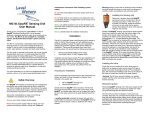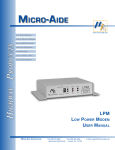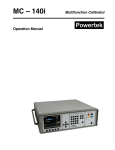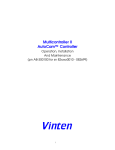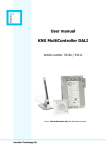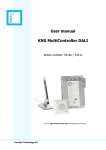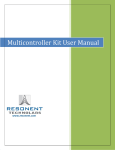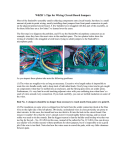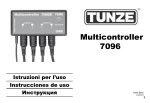Download Multicontroller User Manual
Transcript
Multicontroller User Manual The W8ZR H.F. Receiver Multicontroller is an active 8-channel antenna distribution amplifier, or multicoupler, designed to cover the frequency range 0.1 MHz – 55 MHz. A low-pass filter limits the high-frequency response and an (optional) internal high-pass filter can be installed to limit the low-frequency response below 1.8 MHz. The Multicontroller features a BNC input for 50 Ohm unbalanced (coaxial fed) antennas, and an RCA-type phono jack for high-impedance antennas. It has a front-panel-selectable low-noise preamplifier, and capability for muting any combination of seven receivers. Grounding a control input mutes all seven receivers, and internal protection circuitry disconnects the antenna and mutes all receivers if the external r.f. voltage exceeds 1000 mV. There are seven BNC receiver outputs, plus an auxiliary BNC output which is always active and can be used for an eighth receiver, frequency counter, oscilloscope, etc. The Multicontroller can also be used for testing, production, and frequency measuring and calibration. It will transform almost any impedance to 50 Ohms, can split a signal generator output into 8 isolated outputs. It makes an excellent wideband buffer and line driver and provides a convenient way to control a linear amplifier. I. Front Panel Controls and Operation 1. Power Switch: Connects AC power source to multicontroller, through 1/4A fuse F1 (1/8A for 230 VAC). 2. Antenna Selector Switch: Switches between two possible receive antennas: a 50 Ω coax-fed antenna connected to the rear BNC antenna input, and a high-Z antenna, connected to the rear RCA phono jack high-Z antenna input. The nominal input impedance of the High-Z port is 1000 Ω. It is not recommended to leave this switch in the high-Z position if nothing is connected to the high-Z input, because of the potential for parasitic oscillation of the multicontroller’s internal amplifiers. Oscillation will not damage the Multicontroller but may cause interference or noise with the connected receivers. 3. Preamplifier Switch: Enables a +12dB broadband internal preamplifier, when the 50 Ω antenna input is selected. The preamp can only be enabled when using the 50 Ω antenna input. Because the preamplifier reduces the “headroom” of the internal amplifier stages by 12 db, it is best not to use it unless it is needed to hear weak signals. 4. Mute Enable Switch: Activates the back-panel mute control jack. When the switch is ON, grounding the mute control jack mutes all connected receivers (and turns off their associated LEDs). When OFF, the mute control jack is disconnected. However, 2 connected receivers can still be muted manually by turning OFF their Receiver Enable switches. 5. Receiver Enable Switches (7): Individually enable (unmute) their corresponding receivers. When OFF, the associated receiver is muted. However, even when enabled, all receivers can be muted simultaneously by grounding the rear-panel control jack (provided the Mute Enable Switch is ON). 6. Overload Indicator: This indicator lights when RF voltage on the receive antenna exceeds about 1000 mV. When lighted, all enabled receivers are muted and antenna outputs RX1-RX7 are disabled. (The Aux Output always remains active.) Note that the overload threshold is reduced by 12 db when the preamplifier is turned on. Normally, the overload LED will flicker before the overload relay actuates, thus providing an indication that overload conditions are being approached. II. Rear Panel Connections 1. 50 Ω Antenna BNC Jack: A coaxial fed receive antenna is connected to this jack. The input impedance is a resistive 50 Ω. DC voltages on the antenna should not exceed 50V and RF voltages should not exceed 3.5 Vrms. 2. Hi-Z Antenna Phono Jack: A single wire antenna is connected to this jack, which has a nominal 1000 Ω input impednace. Voltage precautions are the same as for the 50 Ω antenna. 3. Control Phono Jack: Grounding this jack simultaneously mutes all the enabled receivers, provided the Mute Enable switch is ON. Normally, the jack would be controlled by the PTT line or Relay line of the operator’s transmitter or transceiver. If external control is not used, then a shorting plug should be placed in the jack to allow all receivers to be muted simultaneously with the Mute Enable switch. 4. RX1-RX7 BNC Jacks: These are buffered receiver outputs, each having 50 Ω output impedance. These duplicate the signal that appears at either of the antenna input jacks. Note that these outputs are active even when the connected receivers are muted, but that they are inactive (disconnected) if the Overload LED is lighted. 5. Aux Out BNC jack: This buffered output is similar to the RX1-RX7 ports, except that it remains active even if the Overload LED is lighted. This output may be slightly more susceptible to strong signal intermodulation distortion than the other outputs, because back-to-back protective diodes are connected to the input of the Aux Out amplifier stage. 3 6. RX1 – RX7 Phono Jacks: These are mute output jacks. The black jacks (RX4RX7) are normally closed and open when the connected receiver is muted. The red jacks (RX1-RX3) are normally open and close when the connected receiver is muted. Voltage and current limitations of the jacks (see Specifications) should be observed. 7. AC Power Connector: 115 VAC or 230 VAC is connected here, using an ordinary IEC computer-type power cord. The Multicontroller is internally fused, and the user is responsible for verifying that the appropriate fuse (1/4A for 115 VAC or 1/8A for 230 VAC is used.) Note that 230 VAC operation is only possible if a dual primary power transformer (Stancor DSW-520) was installed during assembly. III. General Instructions and Precautions: 1. Up to eight receivers may be connected to the multicontroller, although only seven of them may be muted. BNC cables having a nominal 50 Ω impedance should be connected from ports RX1-RX7 or the Aux Out port to the antenna inputs on the receivers. If the connected receiver’s antenna input has 50 Ω impedance, then the signal from the multicontroller will have the same strength as the signal appearing on the receive antenna (gain of 0 dB). Receivers of the vacuum tube era, or inexpensive modern receivers, may have screw-type antenna terminals whose impedance is greater than 50 Ω. If this is the case, signals from the multicontroller may appear up to 6 dB stronger (voltage gain of x2) than the signals on the antenna, depending on the receiver’s actual input impedance. 2. Ordinary shielded phono cables should be connected from the seven mute output jacks (under the RX1-RX7 BNC connectors) to the mute inputs of the connected receivers. The black phono jacks (RX4-RX7) are normally-closed outputs, which open when the receiver is muted. This open-to-mute convention is the most common and is used for Drake, Collins, Hallicrafters and most other receivers of the vacuum tube era. Military receivers (such as the R-390 and R-390A) and so-called “premium receivers” made by Racal, Watkins-Johnson, Harris, and others typically use a close-to-mute convention and should be connected to the red phono jacks (RX1-RX3). The user can reconfigure any of the mute jacks as close-to-mute or open-to-mute by changing jumpers on the main circuit board. Information about any receiver’s mute requirements can be found in the receiver’s instruction manual. Note that some receivers made in the 1950s and earlier have a front panel “Standby Switch” which is in parallel with rear screw terminals. These terminals are intended to be opened by contacts on an external antenna relay (such as a Dow Key relay) in order to provide muting capability. In some designs, the Standby Switch (and external contacts) simply disconnect plate voltage from the receiver’s tubes. The multicontroller cannot be used to mute such receivers, both because the plate voltage is too high for the multicontroller relay contacts, and because the multicontroller always grounds (or ungrounds) the mute line, which would short to ground the recieiver plate voltage. For such receivers, users should use an external relay to mute the receiver, with the multicontroller controlling the external relay’s coil. 4 IV. Specifications: Amplifier Circuits 1. Frequency Range: 50 Ohm input: 0.1 MHz – 55 MHz 1.8 MHz – 55 MHz Hi – Z input: 0.1 MHz – 55 MHz LF filter not installed LF filter installed 2. Voltage Gain (nominal, per channel): 1.0 (0 dB) 50 Ω load, preamp off 2.0 (6 dB) no load, preamp off There is a broad 3 dB peak in the response from 40-60 MHz. 3. Typical 3 dB Bandwidth: 0.025 MHz – 72 MHz 1.8MHz – 72 MHz 50 Ω load, preamp off, LF filter not installed 50 Ω load, preamp off, LF filter installed 4. Antenna Input (50 Ω ) : Impedance: Clipping threshold: Connector: 50 Ω nominal, d.c. blocked 1300 mV (+18 dBm), preamp off BNC 5. Antenna Input (high-Z) Impedance: Clipping threshold: Connector: 1000 Ω nominal, d.c. blocked 1500 mV, preamp off RCA-type phono 6. Outputs (each channel): Impedance: Connector: 50 Ω nominal, d.c. blocked BNC 7. Preamplifier: +12 dB (nominal) 8. Internal Noise: V < 0.2 µV V < 30 µV 50 Ω input only 1 kHZ bandwidth @ 10 MHz broadband 1.8 – 30 MHz 5 9. Absolute Maximum Input Voltage: Maximum D.C. voltage : Maximum RF voltage ±50 V 3.5 V(rms) 10. Overload Trip Threshold: 1000 mV(rms) nominal 50 Ω and high-Z inputs Mute and Control Circuits 11. Mute Specifications: Independent mute outputs: Configuration: Connector: 7 open-to-mute or close-to-mute, common ground RCA-type phono 12. Mute Relay Ratings: max. switched current: max. switched voltage: 1 A, derate as switched voltage increases 125 VDC (25 mA), 150 VAC (100mA) 13. Control Input (ground to activate): Open-circuit voltage: Short-circuit current: resistance to mute: +12V 1.2 mA <2.2 kΩ General Specifications 14. Power Requirements: 90-130 VAC or 180-260VAC 15 Watts (nominal) fuse: 1/4A 3AG (115V) or 1/8A 3AG (230V) 15. Dimensions: Height: 3.5” (excluding feet) Width: 7.2” Depth: 6.00” 16. Weight: 5 lbs (2.27 kg)







